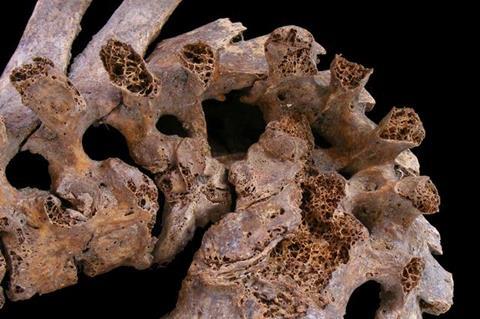Recent research suggests that the emergence of tuberculosis infection in human populations dates back tens of thousands of years earlier than previously known cases in the Middle East. In collaboration with an international research team, Hungarian researchers have edited and published a special issue of the journal Tuberculosis.

In July 2022, the Department of Anthropology of the University of Szeged organised a conference on the paleopathology and evolution of tuberculosis. The ICEPT3 conference was closely linked to the NRDI-best funded research project of György Pálfi (Department of Anthropology, Szeged University), and the presentations of researchers from all over the world provided a comprehensive overview of the history of the pathogen, going beyond the previous knowledge.
Carpathian clues
In the last decades, the historical Carpathian Basin has become the best-researched region in the world in terms of TB infection, primarily as a result of the work of researchers from the Department of Biological Anthropology at the Faculty of Science and Informatics at University of Szeged the Department of Biological Anthropology at the Faculty of Science at Eötvös Loránd University and the Department of Anthropology at the Hungarian Natural History Museum.
Recent analyses by György Pálfi, Ildikó Pap, and their colleagues suggest Neanderthal specimens from Subalyuk cave (Hungary), who lived more than 32,000 years ago, may have also suffered from TB infection. These new scientific discoveries place the appearance of tuberculosis in human populations tens of thousands of years earlier than the earliest known cases.
Well-known pioneer
The first section of this Tuberculosis Supplement issue is dedicated to the memory of Professor David Ernest Minnikin, an outstanding scholar of TB evolution and a well-known pioneer in the field of mycobacterial research, who died in 2021. In the first articles, the authors commemorate his outstanding work and the remarkable findings which have enriched both the modern and ancient mycobacterial research community.
The following papers are about essential ancient TB research results with active contributions by Professor Minnikin and collaborators: the above-mentioned discovery and analysis of paleopathological and paleomicrobiological traces of TB infection in the Subalyuk Neanderthal remains (Hungary). These results are of great importance for our knowledge of the evolution of tuberculosis, and these studies are closely related to the subjects of the articles that follow.
Two studies led by doctoral students from the Department of Biological Anthropology at ELTE have contributed significantly to the detailed exploration of the evolution of tuberculosis, reviewing previously known and publishing newly identified cases from inside the borders of today’s Hungary.
Bronze Age
Anett Gémes and colleagues presented a detailed review of 18 cases alongside the introduction of 7 new cases. Three of the seven cases are from the Bronze Age (2600/2500-800 BC) when cases of skeletal tuberculosis from the Carpathian Basin had not been reported.
Krisztián Kiss and colleagues have reviewed 114 previously published cases of TB with the publication of the detailed description of an additional 39 new cases.
Thus, a comprehensive database representing the Carpathian Base of 2nd-16th centuries was established. Primary data (sex and age) and detailed description of pathological alterations are available for the affected individuals, illustrated by photo- and radiographs. It would not have been possible to collect this large number of cases without close cooperation between the Departments of Biological Anthropology of ELTE and SZTE, and between several other institutions, anthropologists, and archaeologists.
All articles in the volume will be available free of charge until 14 January 2024 at the following link (5 studies are Open Access and will remain available for download): https://www.sciencedirect.com/journal/tuberculosis/vol/143/suppl/S
Skeletal tuberculosis
As the database includes detailed paleopathological descriptions furthermore photo- and radiographic documentations for skeletal tuberculosis, a deeper understanding of the natural course, macromorphological and radiological manifestation of the disease can be achieved. Thus, besides revealing temporal and spatial trends based on the results, the study can be also considered significant contribution to the paleopathological and clinical disciplines.
The conference and the accompanying special issue of Tuberculosis Journal highlight how a broad national collaboration in a given field, supported by an international network of researchers, can achieve tremendous and internationally outstanding results.
The number of cases representing this relatively small geographical region is unique around the globe, which is the result of the hard work of Hungarian anthropologists in the last decades. The many identified TB cases with the detailed descriptions provide a good basis for designing future molecular studies and test multiple hypotheses better to understand the evolutionary history of tuberculosis pathogen strains.
Conference proceedings
The entire proceedings of the conference were published in December 2023 in the prestigious journal Tuberculosis. An outstanding Hungarian-French-Italian collaboration among the University of Szeged, the Ecole Pratique des Hautes Etudes, the Eötvös Loránd University, the Université Paris-Saclay, and the Eurac Research has resulted in the publication of the latest international TB evolution research results.
The volume was edited in an international collaboration, thanks to the guest editorship of György Pálfi from Szeged University (Szeged, Hungary), Olivier Dutour from Ecole Pratique des Hautes Etudes - PSL University Paris and CNRS, Université Bordeaux Montaigne (France), Tamás Hajdu from ELTE (Budapest, Hungary), Christophe Sola from Université Paris-Saclay, Université Paris-Cité (France) and Albert Zink from Institute for Mummy Studies, EURAC Research (Bolzano, Italy). Of the 22 studies included, 10 are partly or entirely the work of Hungarian researchers.
Topics
- Anett Gémes
- Bacteria
- Carpathian Basin
- David Ernest Minnikin
- Ecole Pratique des Hautes Etudes
- Ecology & Evolution
- Eötvös Loránd University
- Eurac Research
- György Pálfi
- Ildikó Pap
- Infectious Disease
- Krisztián Kiss
- mycobacteria
- Neanderthals
- One Health
- Research News
- Subalyuk
- tuberculosis
- UK & Rest of Europe
- Université Paris-Saclay
- University of Szeged







No comments yet